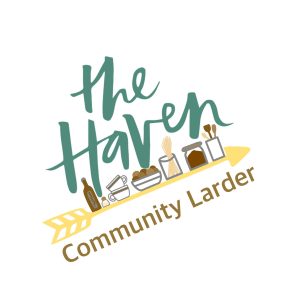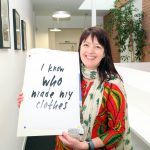Your Garment Stories
HRDPW - The Story of your Recycled Plastic Haven Bag for Life
This is the story of your Haven Bag for Life, designed and created especially for the Haven, Stonehaven.
H – The Haven, Stonehaven
We are creating, nurturing and empowering our community spirit at The Haven in Stonehaven. Prior to the pandemic we did this in our wellbeing space but during lockdown our community’s needs changed. With rising levels of food insecurity and food poverty we responded by creating The Haven Community Larder. Everyone who is a supporter will receive a bag for life.
Our “Be the change you want to see” bag for life is our way:
- – To challenge food poverty stigma.
- – Reduce the use of plastic bags.
- – Become more sustainable in managing stock.
We wanted to ensure that our bag was made in a way that was as eco and as ethical as possible to reflect our values. The pandemic presented a real barrier to be able to source the number of bags required and we put a call out to other social enterprises on Twitter and we are grateful “Where Does it Come From,” answered. Being able to collaborate with another UK social enterprise that was more experienced with this process was hugely reassuring in an uncertain time.
R – Recycled Plastic (RPET) Haven Bag for Life
Your Haven Bag For Life is made from RPET – short for recycled polyethylene tetraphyte.
There are many different types of plastic, each made from a specific polymer. PET plastic is made from crude oil, which is extracted from under the earth. We now know how damaging these processes are to our environment – both the extraction of fossil fuels such as crude oil and the manufacturing process used to turn it into plastic . PET is used for packaging and also clothing, where it is called polyester. Polyester accounts for around 60% of our clothes.
Since the invention of plastic, the human race has created over 90 billion tonnes of the stuff. Unfortunately once plastic exists it will stay with us in some form – it doesn’t biodegrade, just breaks down into tiny microplastics. Fortunately PET can be recycled and this is an excellent way to re-use the plastic that already exists, avoiding the harmful processes required to make virgin plastics. Unfortunately only around 20% of plastic is currently recycled.
Your Haven Bag For Life is part of this positive story of recycling. The fabric for your bag created from plastic bottles in a process that uses 50% less energy than creating virgin plastic. Using RPET also prevents those bottles ending up in landfill and creating micro-plastics to leach into our water and food systems.
D – Print Design – Haven Bag for Life
The beautiful design for your Haven Bag for Life was created especially for The Haven by Laura from Juniper Press. Laura is a designer, illustrator and printmaker based in Portlethen, Aberdeenshire. She graduated in graphic design and started her own business, Juniper Press, in 2015. Laura’s work has a distinct monochromatic style. She takes inspiration from the intricacies and detail of Scandinavian and Eastern European folk art, using nature and plants as her subject matter.
P – Printing your Haven Bag For Life
Your Haven Bag for Life was printed by Adam and Zak of Ipswich Embroidery and Print.
Adam created a print screen, using the design from Laura. The print screen has small holes corresponding to the design so that when inks are smoothed over it, they create the design on the fabric below.
After printing the bags were then laid out to dry, before being packed and shipped to The Haven.

Overcoming Challenges…
Unfortunately it soon became apparent that the recycled plastic bags had a manufacturing fault and were not fit for purpose. The bags started to rip when filled with groceries – some customers even had to sew another plastic bag into the inside to strenthen it!


The original bag supplier, DTB (Direct Trade Bags) admitted the fault but were reluctant to replace them – requiring every single bag to be returned to them. This was not practical as many customers had simply thrown theirs away. Also this required a lot of work from the Haven team to collate and post the 500 bags. After months of wrangling and some assertive conversations with the DTB team by Adam, they finally agreed to replace all 500 bags with organic cotton bags. They would not pay for the costs of reprinting these though, which were kindly met by Ipswich Embroidery and Print.
The problem was solved through teamwork of 3 small organisations and a valuable lesson in building trusted relationships with suppliers. Here is a photo of one of the replacement organic cotton bags, posing at an allotment.

W – Where Does It Come From?
This project was managed by Jo from Where Does It Come From?, a social enterprise based in Suffolk.
Where Does It Come From? was set up in 2013 to create clothing and textiles that are kind to the planet and the people who make them. We also believe that they are kind to you too, because knowing the story gives you peace of mind that you are supporting projects that help the environment and are fair to the makers.
Every item we create comes with a code so you can explore its story, learning about the eco-friendly materials and processes and getting to know the people involved.
You can find out more about what we do and browse our website shop at www.wheredoesitcomefrom.co.uk








